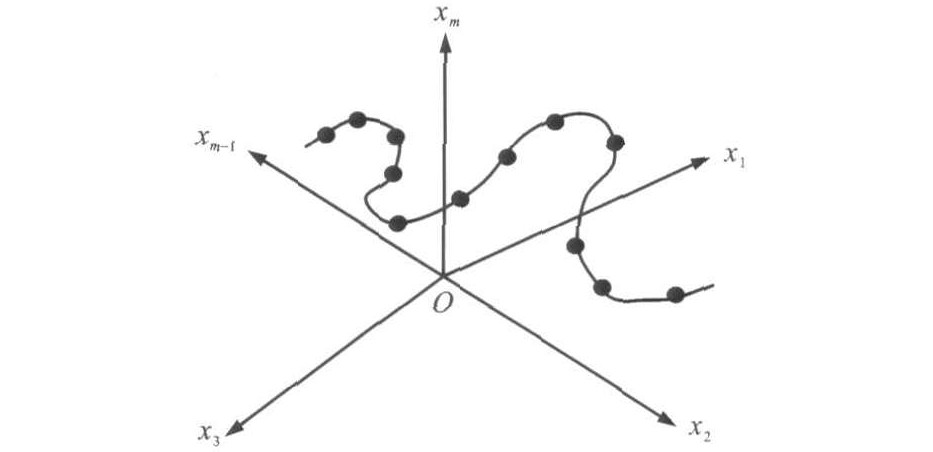-
摘要: 针对客运专线特大桥沉降提出混沌行为测定方法, 利用非线性理论与混沌时间序列方法, 建立了铁路客运专线特大桥沉降预测模型。采用嵌入定理, 对特大桥沉降时间序列进行重构。通过计算相关维度、Kolmogorov熵、最大Lyapunov指数来测定该时间序列的混沌行为特征, 并以石武客运专线某座特大桥A、B桥墩为例进行实例研究。计算结果表明: 利用沉降预测模型, A桥墩的最大沉降量为0.072 5mm, 最小沉降量为0.020 1mm, B桥墩最大沉降量为0.069 7mm, 最小沉降量为0.030 4mm, 预测值和实际值误差均在±0.005 0mm范围内。可见, 预测模型有效, 预测结果满足桥梁沉降变形监测技术要求。Abstract: Aiming at the settlement of super large bridge for passenger dedicated railway, the calibration method of chaotic behavior was put out.The nonlinear theory and chaotic time sequence method were used, and the settlement prediction model of super large bridge for passenger dedicated railway was set up.Based on embedding theory, the settlement time sequence of super large bridge was reconstructed.Through calculating the values of correlation dimension, Kolmogorov entropy and maximum Lyapunov exponent, the chaotic behavior characteristic of time sequence was verified.The piers A and B of a super large bridge for Shijiazhuang-Wuhan Passenger Dedicated Railway were taken as examples, and the settlements were calculated.Calculation result shows that by using the settlement prediction model, the maximum settlement of pier A is 0.072 5 mm, and the minimum settlement of pier A is 0.020 1 mm.The maximum settlement of pier B is 0.069 7 mm, the minimum settlement of pier B is 0.030 4 mm, and the errors between prediction values and actual values are less than ±0.005 0 mm.So the prediction model is effective, and the prediction results meet the technical requirement of bridge settlement deformation monitoring.
-
表 1 A桥墩沉降量
Table 1. Settlements of pier A
观测日期 累计天数/d 时间间隔/d 所处位置 本次沉降量/mm 总沉降量/mm 沉降速度/(mm·d-1) 2009-02-09 0 0 线路右侧小里程 0.00 0.00 0.000 2009-02-16 7 7 线路右侧小里程 -0.02 -0.02 -0.003 2009-02-23 14 7 线路右侧小里程 -0.02 -0.04 -0.003 2009-03-02 21 7 线路右侧小里程 -0.02 -0.06 -0.003 2009-03-09 28 7 线路右侧小里程 -0.01 -0.07 -0.001 2009-03-16 35 7 线路右侧小里程 0.03 -0.04 0.003 2009-03-23 42 7 线路右侧小里程 -0.07 -0.11 -0.014 2009-03-30 49 7 线路右侧小里程 -0.02 -0.13 -0.003 2009-04-06 56 7 线路右侧小里程 -0.02 -0.15 -0.003 2009-04-13 63 7 线路右侧小里程 0.04 -0.11 0.006 2009-04-20 70 7 线路右侧小里程 -0.07 -0.18 -0.010 -
[1] 钟承奎, 牛明飞. 关于无穷维耗散非线性动力系统全局吸引子的存在性[J]. 兰州大学学报: 自然科学版, 2003, 39(2): 1-5. https://www.cnki.com.cn/Article/CJFDTOTAL-LDZK200302000.htmZHONG Cheng-kui, NIU Ming-fei. On the existence of global attractor for a class of infinite dimensional dissipative nonlinear dynamic systems[J]. Journal of Lanzhou University: Natural Sciences, 2003, 39(2): 1-5. (in Chinese) https://www.cnki.com.cn/Article/CJFDTOTAL-LDZK200302000.htm [2] 李凡, 段建立, 吴敏. 采用混沌变异演化算法在边坡稳定分析中的应用[J]. 合肥工业大学学报: 自然科学版, 2002, 25(1): 109-112. doi: 10.3969/j.issn.1003-5060.2002.01.026LI Fan, DUAN Jian-li, WU Min. Application of an evolution program with chaos mutation to the analysis of slope stability[J]. Journal of Hefei University of Technology: Natural Science, 2002, 25(1): 109-112. (in Chinese) doi: 10.3969/j.issn.1003-5060.2002.01.026 [3] 毕龙珠, 王腾军, 杨海彦, 等. 混沌时间序列在建筑物沉降预测中的应用研究[J]. 测绘信息与工程, 2009, 34(2): 49-51. https://www.cnki.com.cn/Article/CJFDTOTAL-CHXG200902024.htmBI Long-zhu, WANG Teng-jun, YANG Hai-yan, et al. Application of chaos time series to subsidence forecasting[J]. Journal of Geomatics, 2009, 34(2): 49-51. (in Chinese) https://www.cnki.com.cn/Article/CJFDTOTAL-CHXG200902024.htm [4] 夏银飞, 张季如, 夏元友. 混沌时间序列在路基工后沉降中的应用[J]. 华中科技大学学报: 城市科学版, 2005, 22(3): 89-93. https://www.cnki.com.cn/Article/CJFDTOTAL-WHCJ200503022.htmXIA Yin-fei, ZHANG Ji-ru, XIA Yuan-you. Application of chaotic time series on road foundation's sedimentation[J]. Journal of Huazhong University of Science and Technology: Urban Science Edition, 2005, 22(3): 89-93. (in Chinese) https://www.cnki.com.cn/Article/CJFDTOTAL-WHCJ200503022.htm [5] 李峰, 宋建军, 董来启, 等. 基于混沌神经网络理论的城市地面沉降量预测模型[J]. 工程地质学报, 2008, 16(5): 715-720. doi: 10.3969/j.issn.1004-9665.2008.05.026LI Feng, SONG Jian-jun, DONG Lai-qi, et al. Chaos neural network theory based model for quantitative prediction of urban ground subsidence[J]. Journal of Engineering Geology, 2008, 16(5): 715-720. (in Chinese) doi: 10.3969/j.issn.1004-9665.2008.05.026 [6] ROSE B T. Tennessee rockfall management system[D]. Blacksburg: Virginia Polytechnic Institute and State University, 2005. [7] GHOLIPOUR A, ARAABI B, LUCAS C. Predicting chaotic time series using neural and neurofuzzy models: a comparative study[J]. Neural Process Letters, 2006, 24(3): 217-239. doi: 10.1007/s11063-006-9021-x [8] 陈健. 基坑变形的混沌时间序列分析方法及应用研究[J]. 测绘, 2011, 34(2): 57-59. https://www.cnki.com.cn/Article/CJFDTOTAL-SCCH201102004.htmCHEN Jian. Analytic method and application about chaotic foundation pit deformation time-series[J]. Surveying and Mapping, 2011, 34(2): 57-59. (in Chinese) https://www.cnki.com.cn/Article/CJFDTOTAL-SCCH201102004.htm [9] 陈铿, 韩伯棠. 混沌时间序列分析中的相空间重构技术综述[J]. 计算机科学, 2005, 32(4): 67-70. doi: 10.3969/j.issn.1002-137X.2005.04.021CHEN Keng, HAN Bo-tang. A survey of state space reconstruction of chaotic time series analysis[J]. Computer Science, 2005, 32(4): 67-70. (in Chinese) doi: 10.3969/j.issn.1002-137X.2005.04.021 [10] 汤琳, 杨永国. 混沌时间序列分析及应用研究[J]. 武汉理工大学学报, 2010, 32(19): 189-192. https://www.cnki.com.cn/Article/CJFDTOTAL-WHGY201019046.htmTANG Lin, YANG Yong-guo. Chaotic time series analysis and its application research[J]. Journal of Wuhan University of Technology, 2010, 32(19): 189-192. (in Chinese) https://www.cnki.com.cn/Article/CJFDTOTAL-WHGY201019046.htm [11] 孙海云, 曹庆杰. 混沌时间序列建模及预测[J]. 系统工程理论与实践, 2001, 21(5): 106-113. doi: 10.3321/j.issn:1000-6788.2001.05.017SUN Hai-yun, CAO Qing-jie. The modeling and forecasting of chaotic time series[J]. Systems Engineering—Theory and Practice, 2001, 21(5): 106-113. (in Chinese) doi: 10.3321/j.issn:1000-6788.2001.05.017 [12] 马红光, 李夕海, 王国华, 等. 相空间重构中嵌入维和时间延迟的选择[J]. 西安交通大学学报, 2004, 38(4): 335-338. doi: 10.3321/j.issn:0253-987X.2004.04.002MA Hong-guang, LI Xi-hai, WANG Guo-hua, et al. Selection of embedding dimension and delay time in phase space reconstruction[J]. Journal of Xi'an Jiaotong University, 2004, 38(4): 335-338. (in Chinese) doi: 10.3321/j.issn:0253-987X.2004.04.002 [13] 李红霞, 许士国, 徐向舟, 等. 混沌理论在水文领域中的研究现状及展望[J]. 水文, 2007, 27(6): 1-5, 58. https://www.cnki.com.cn/Article/CJFDTOTAL-SWZZ200706000.htmLI Hong-xia, XU Shi-guo, XU Xiang-zhou, et al. Current status and prospect of chaos theory research in hydrology[J]. Journal of China Hydrology, 2007, 27(6): 1-5, 58. (in Chinese) https://www.cnki.com.cn/Article/CJFDTOTAL-SWZZ200706000.htm [14] 高雷阜. 煤与瓦斯突出的混沌动力系统演化规律研究[D]. 阜新: 辽宁工程技术大学, 2006.GAO Lei-fu. Study on chaotic dynamical system evolution of coal and gas outburst[D]. Fuxin: Liaoning Technical University, 2006. (in Chinese) [15] AYATT N E, CHERIET M, SUEN C Y. Automatic model selection for the optimization of SVM kernels[J]. Pattern Recognition, 2005, 38(10): 1733-1745. doi: 10.1016/j.patcog.2005.03.011 [16] LEE P H, CHEN Yi, PEI S C, et al. Evidence of the correlation between positive lyapunov exponents and good chaotic random number sequences[J]. Computer Physics Communications, 2004, 160(3): 187-203. doi: 10.1016/j.cpc.2004.04.001 [17] KIM H S, EYKHOH R, SALAS J D. Nonlinear dynamics, delay times, and embedding windows[J]. Physicra D: Nonlinear Phenomena, 1999, 127(1/2): 48-60. [18] KOJIMA C, RAPISARDA P, TAKABA K. Lyapunov stability analysis of higher-order 2-D systems[C]∥IEEE. Pre-ceedings of the 48th IEEE Conference on Decision and Control. Shanghai: IEEE, 2010: 1734-1739. [19] 陈益峰, 吕金虎, 周创兵. 基于Lyapunov指数改进算法的边坡位移预测[J]. 岩石力学与工程学报, 2001, 20(5): 671-675. doi: 10.3321/j.issn:1000-6915.2001.05.014CHEN Yi-feng, LU Jin-hu, ZHOU Chuang-bing. Prediction of slope displacement by using Lyapunov exponent improved technique[J]. Chinese Journal of Rock Mechanics and Engineering, 2001, 20(5): 671-675. (in Chinese) doi: 10.3321/j.issn:1000-6915.2001.05.014 [20] 郁俊莉, 王其文. Lyapunov指数混沌特性判定研究[J]. 武汉理工大学学报, 2004, 26(2): 90-92. doi: 10.3321/j.issn:1671-4431.2004.02.028YU Jun-li, WANG Qi-wen. Research of judging the chaotic characteristics with the Lyapunov exponents[J]. Journal of Wuhan University of Technology, 2004, 26(2): 90-92. (in Chinese) doi: 10.3321/j.issn:1671-4431.2004.02.028 [21] 张安兵, 高井祥, 刘新侠, 等. 边坡变形时序非线性判定及混沌预测研究[J]. 中国安全科学学报, 2008, 18(4): 55-60. https://www.cnki.com.cn/Article/CJFDTOTAL-ZAQK200804009.htmZHANG An-bing, GAO Jing-xiang, LIU Xin-xia, et al. Nonlinear test and chaotic prediction of slope deformation sequences[J]. China Safety Science Journal, 2008, 18(4): 55-60. (in Chinese) https://www.cnki.com.cn/Article/CJFDTOTAL-ZAQK200804009.htm [22] 付义祥, 刘志强. 边坡位移的混沌时间序列分析方法及应用研究[J]. 武汉理工大学学报: 交通科学与工程版, 2003, 27(4): 473-476. doi: 10.3963/j.issn.2095-3844.2003.04.013FU Yi-xiang, LIU Zhi-qiang. Analytic method and application about chaotic slope deformation destruction time series[J]. Journal of Wuhan University of Technology: Transportation Science and Engineering, 2003, 27(4): 473-476. (in Chinese) doi: 10.3963/j.issn.2095-3844.2003.04.013 [23] 张勇, 关伟. 基于最大Lyapunov指数的多变量混沌时间序列预测[J]. 物理学报, 2009, 58(2): 756-763. doi: 10.3321/j.issn:1000-3290.2009.02.012ZHANG Yong, GUAN Wei. Predication of multivariable chaotic time series based on maximal Lyapunov exponen[J]. Acta Physica Sinica, 2009, 58(2): 756-763. (in Chinese) doi: 10.3321/j.issn:1000-3290.2009.02.012 [24] 张勇, 关伟. 基于最大李亚普诺夫指数的改进混沌时间序列预测[J]. 信息与控制, 2009, 38(3): 360-364. doi: 10.3969/j.issn.1002-0411.2009.03.019ZHANG Yong, GUAN Wei. An improved method for forecasting chaotic time series based on maximum Lyapunov exponent[J]. Information and Control, 2009, 38(3): 360-364. (in Chinese) doi: 10.3969/j.issn.1002-0411.2009.03.019 [25] 向昌盛, 张林峰. 混沌时间序列预测模型参数同步优化[J]. 计算机工程与应用, 2011, 47(1): 4-7. https://www.cnki.com.cn/Article/CJFDTOTAL-JSGG201101003.htmXIANG Chang-sheng, ZHANG Lin-feng. Simultaneous optimization of chaotic time series prediction model parameters[J]. Computer Engineering and Applications, 2011, 47(1): 4-7. (in Chinese) https://www.cnki.com.cn/Article/CJFDTOTAL-JSGG201101003.htm [26] 韩敏, 魏茹. 基于改进典型相关分析的混沌时间序列预测[J]. 大连理工大学学报, 2008, 48(2): 292-297. https://www.cnki.com.cn/Article/CJFDTOTAL-DLLG200802026.htmHAN Min, WEI Ru. Chaotic time series prediction based on modified canonical correlation analysis[J]. Journal of Dalian University of Technology, 2008, 48(2): 292-297. (in Chinese) https://www.cnki.com.cn/Article/CJFDTOTAL-DLLG200802026.htm -





 下载:
下载:







